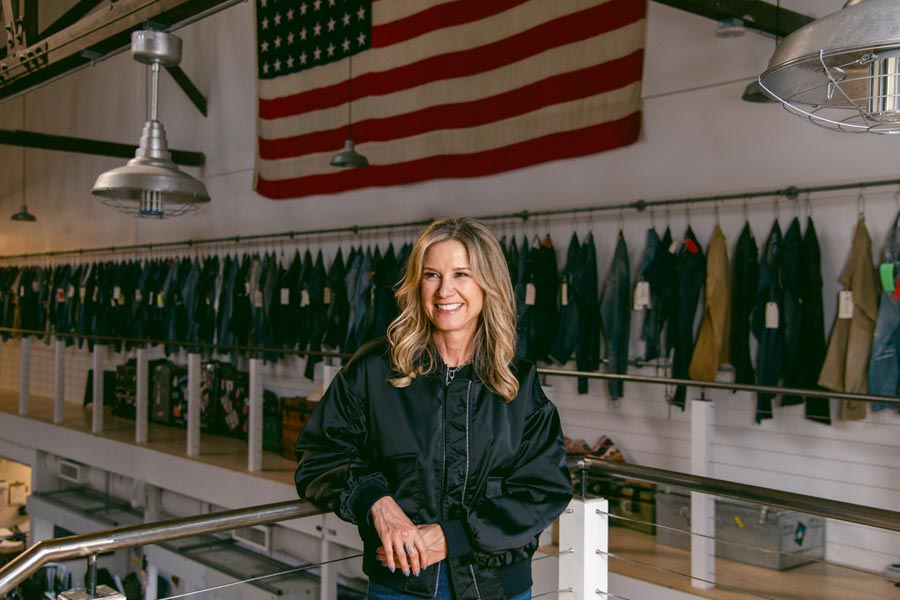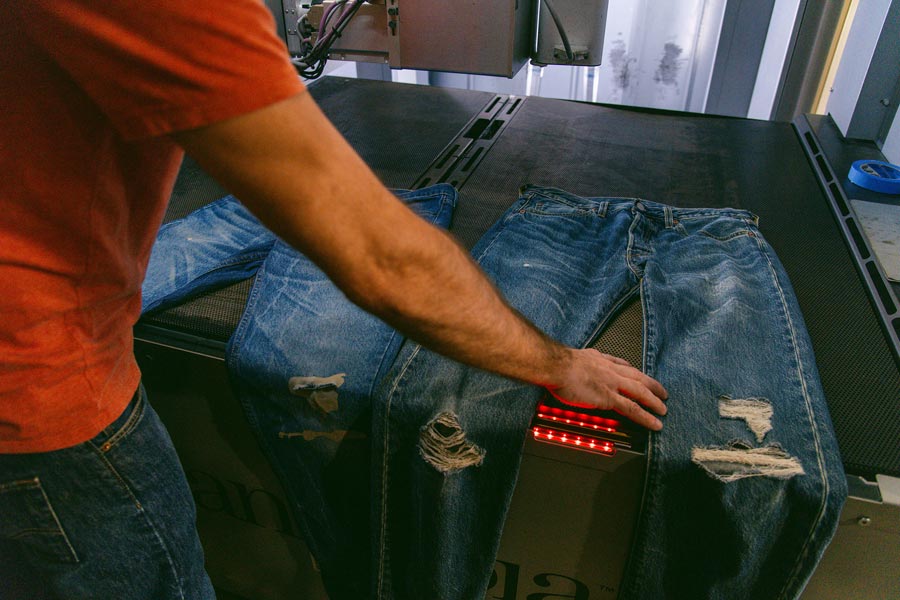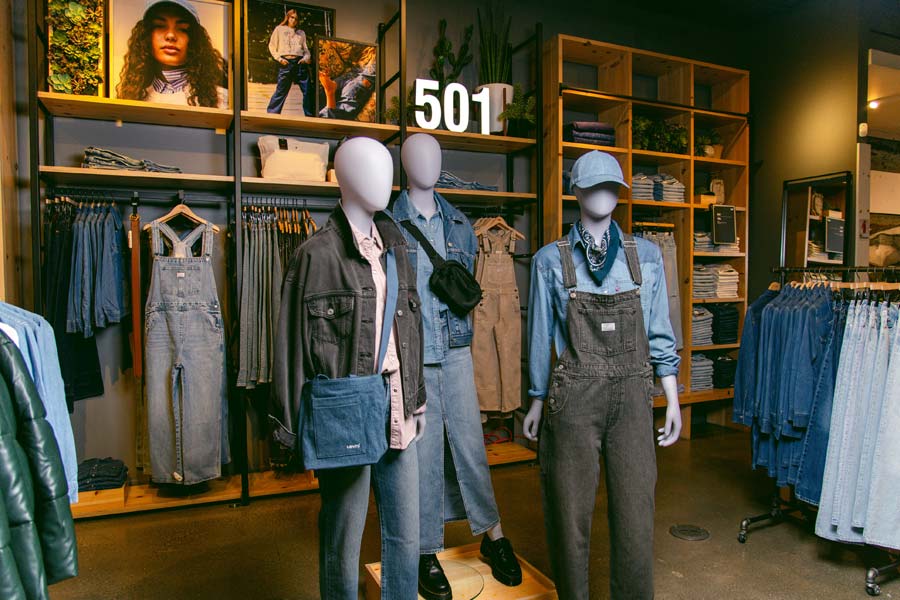In the Levi’s store on Market Street in San Francisco, the denim maker’s newly extended collection is on full display. Its mannequins are dressed head to toe in its trademark denim. Black denim overalls are paired with a light-blue long-sleeve denim blouse, complemented by a denim cap. Another dons a denim cross-body bag. A wall of blue jean jackets gives shoppers the option to feel like a hippie, rancher or rock star — depending on which they choose.
“It isn’t just walls and walls of jeans,” Michelle Gass said as she scanned the store this month, days after becoming the CEO of Levi Strauss & Co. The assortment of tops, which Levi’s has been producing at a faster rate than it has in the past, was equal to the store’s inventory of jeans.
That day, Gass’ outfit also served as an example of what the company was going for. She had swapped out her signature black leather jacket that was her go-to look during her time as Kohl’s CEO for a dark-wash Levi’s trucker jacket and a ’90s-inspired midi denim skirt to match.
Gass, 55, wants to make Levi’s not only a brand you think of when you want jeans, but also a place you go to first when shopping for shirts, jumpsuits and puffer jackets. Her goal is to get customers back more often — since people usually buy tops more frequently than bottoms — and to bring them to Levi’s stores, its website and its mobile app.
“When you’re building stores, when you’re creating an e-commerce site, the consumer wants to explore and shop more than just for a pair of jeans,” Gass said.

Michelle Gass, the new chief executive of Levi Strauss & Co., at the company’s Eureka Lab in San Francisco, Feb. 1, 2024. Marissa Leshnov/The New York Times
The approach is a key element in turning the 171-year-old clothier into a true retailer rather than a brand that sells its wares primarily in other companies’ stores.
Sales through its direct-to-consumer channels, known in the industry as DTC, increased 11% in its most recent quarter, while Levi’s sales through retailers such as Macy’s, Kohl’s and Amazon declined 2%. Overall sales at the company were flat in 2023 compared to the year before.
This is the tough math that Levi’s contends with as investors continue to expect growth from it. Last year, revenue was $6.2 billion. In January, the denim company told Wall Street it planned to increase total sales to $9 billion to $10 billion eventually. It did not set a specific target date for doing so.
But what Gass and her senior leadership team have been very clear about is that its stores and the assortment of products it can place there will play a significant role in achieving that revenue goal. Within six years, it wants 55% of its revenue to come from its direct-to-consumer business, up from the current 42%.
“It really is moving this company to be, I’ll call it, a denim lifestyle retailer,” Gass said. “That’s the big pivot.”
The Levi’s stores aren’t new. It opened its first retail shop in 1983 in Spain; the first one in the United States opened in Columbus, Ohio, in 1991.
But most of the company’s sales still came through chains like Macy’s or Nordstrom. The ways shoppers buy things have changed vastly since then. As department stores and malls struggle with the increasingly e-commerce world, brands such as Levi’s and Nike have responded by beefing up their own direct-to-consumer channels to strengthen their ties to consumers and control their brand more tightly.
“You’re able to showcase the brand and the direction that you want the brand to evolve,” Jim Duffy, a retail analyst at Stifel, said of physical stores. “That can be more difficult to do in a wholesale environment, where they oftentimes tend to sell brands as items, rather than collections.”
Levi’s now has nearly 2,300 stores across the world, including 244 in the United States. Last year, it had a record number of store openings: 105.
“The consumer is going to buy directly from the brands,” Gass said. “There’s the overarching consumer trend that’s gravitating to really wanting a DTC experience and then we’ve got this next chapter for us where we’re still really underdeveloped in our direct-to-consumer footprint.”
To morph into a company that thinks like a retailer first, Levi’s will have to go through some growing pains. Gass has identified some. Over the past year, while she was Levi’s president and preparing to succeed the longtime CEO, Chip Bergh, she toured the company’s stores across 15 markets. She took six trips to Asia.
From those trips, she saw ways that Levi’s business was more developed in other parts of the world. For example, in India, the company sells one shirt for every pair of bottoms. In the United States, it’s one shirt for every four jeans. She wants parity in that ratio.
She also concluded that decisions could be made much quicker. It took 15 months to develop and deliver shirts — about the time it took for denim bottoms, yet too slow to constantly bring in shoppers and motivate them to return. The company enlisted new vendors and is speeding up that timeline.
It’s making seemingly minute changes, too. Levi’s jeans were folded for shipping to conform to the way they are displayed by other retailers — but Levi’s own stores display them differently. That left Levi’s store workers arduously refolding jeans. Now orders to Levi’s stores are shipped to reflect the way the store will display them.

A Levi’s employee compares a pair of jeans that have been washed, right, with a fresh pair of jeans at the company’s Eureka Lab in San Francisco, Feb. 1, 2024. Marissa Leshnov/The New York Times
Levi’s is focusing on training and keeping its store workers engaged by using short, TikTok-like training videos, and is experimenting with the ways that artificial intelligence can help store workers more easily answer customers’ questions (“What’s the advantage of Japanese selvedge denim?”). It is also improving systems that let distribution centers know when hot-selling products are running low in stores — a leading frustration for shoppers expecting to find their size. Getting products from distribution centers to stores has also been streamlined to match inventory to the season.
Such practices are table stakes for a retailer these days. But it is the next evolution for a brand that for a time lost its footing. A decade ago, Levi’s faced the existential crisis of making its denim relevant as young people opted for leggings.
The company figured it out. They made stretchier jeans, opened stores in tony neighborhoods and capitalized on moments like Beyoncé wearing 501-style cutoff shorts during her 2018 performance at the Coachella Valley Music and Arts Festival. It became a publicly traded company for a second time in 2019, pushing it further into the spotlight. Last year, Levi’s was the top-selling denim brand in the United States and worldwide, according to data from Euromonitor, a market research firm.
Inside its San Francisco headquarters, an array of denim pants, jackets and shirts hang on racks. Dawn Vitale, Levi’s chief merchandising officer, describes the latest assortment as “denim lifestyle,” where one can be decked out with full-on denim regalia. Prices for jeans range from about $60 to more than $400 for specialty selvedge denim, with some items in special collaborations being higher.
The logic is that when Levi’s introduces a new cut of jeans, there is a nearby blouse or jacket they can present to shoppers that would pair well with it. “It’s actually a strategy of outfitting,” Vitale said.
Still, as it expands its offerings to fill its stores, Levi’s direct-to-consumer business is less profitable than its wholesale business. Gass said it had a “line of sight” into increasing the profitability of its stores and e-commerce platforms.
Levi’s is trying to save costs where it can. During its quarterly earnings call in late January, the company said it would slash 10% to 15% of its workforce, a move that would save $100 million this year. Gass declined to share which roles were being cut, but said the company was looking to “reduce layers in the organization.” It also said it would stop making 15% of its lowest-selling items.
“We’re changing the way we’re working,” she said. “This operating model is going to look for all those opportunities where we can be decisive as a culture.”
The New York Times News Service











